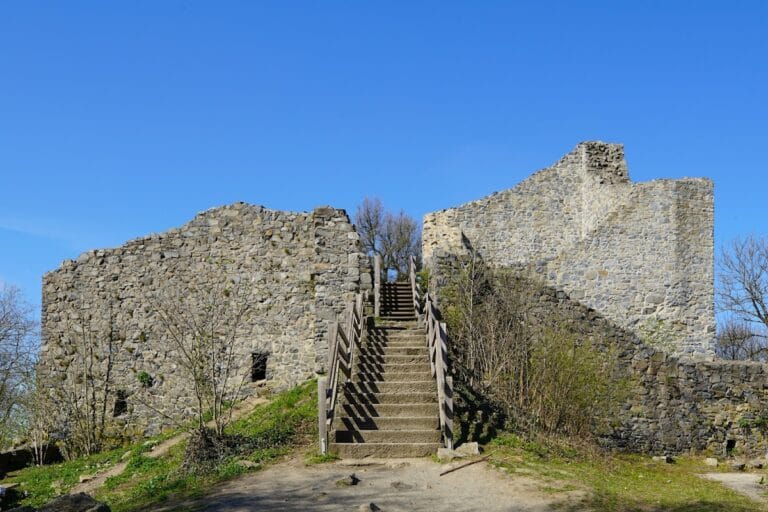Tomburg Castle: A Historic Hilltop Fortress in Germany
Visitor Information
Google Rating: 4.6
Popularity: Low
Google Maps: View on Google Maps
Official Website: www.tomburg-forschung.de
Country: Germany
Civilization: Medieval European
Remains: Military
History
Tomburg Castle is located near Rheinbach in present-day Germany. It was constructed around the year 900, built by local rulers as a fortified hilltop stronghold. The site itself had been occupied centuries earlier; archaeological evidence shows that the Romans settled on the Tomberg hill, using it for strategic purposes during the 4th century.
By around the year 1000, the castle gained prominence as the residence of Count Palatine Ezzo and his wife Mathilda, who was the sister of Emperor Otto III. Their family was influential in regional and European affairs: their daughter Richeza became Queen of Poland, while their son Otto inherited the Palatinate, served as Duke of Swabia from 1045 until his death at the castle in 1047. During this period, Tomburg formed part of the power network surrounding the Holy Roman Empire’s ruling elite.
In the mid-11th century, authority over the castle shifted to the Archbishopric of Cologne. This transition was officially confirmed by Pope Leo IX in 1052, granting the archbishopric control not only over Tomburg itself but also its associated church. Following this, beginning in 1090, the castle was held by the Counts of Cleves as vassals under the archbishops. Their control lasted until the 13th century, when the Lords of Müllenark took ownership. This family adopted the name “von Tomburg” and in 1253 gained the office of burgrave, a title denoting their role as castle governors and local lords.
Over the centuries, Tomburg Castle’s military importance declined, especially during the 14th century as the emergence of gunpowder artillery transformed warfare and rendered many hilltop fortifications less defensible. During this later period, the von Tomburg family reportedly used the castle more as a refuge and engaged in acts typical of robber barons, disrupting regional trade and security.
Following the death of a key family member around 1420, the castle passed through several lines of inheritance, which led to conflicts involving Frederick of Tomburg and Duke Gerhard VII of Jülich. These disputes culminated on September 7, 1473, when forces under Duke Gerhard VII besieged the castle. The assault employed artillery that severely damaged the fortress, leading to its near-total destruction. After this event, Tomburg Castle was abandoned and was never rebuilt or used as a military stronghold again.
In the centuries that followed, local inhabitants quarried basalt from the volcanic hill, causing further deterioration to the site. However, archaeological interest resumed in the 19th century when a local heritage society excavated the castle’s well in 1883. More recently, efforts to protect and conserve the ruins began in 2017, supported by dedicated heritage organizations aimed at preserving its cultural legacy.
Remains
The ruins of Tomburg Castle occupy a hilltop basalt dome known as Tomberg, formed by volcanic activity during the Tertiary period. This dome, measuring approximately 309.7 to 316 meters high, features an elliptical volcanic vent roughly 175 meters across. Around 70 percent of the original volcanic hill remains intact today, a testament to the site’s natural and historical endurance despite centuries of quarrying.
Key among the surviving features is the remains of the bergfried, the castle’s main tower. Although its upper sections have crumbled, the lower portion stands still and has been fenced off to protect it from further damage. The bergfried would have served as a lookout point and stronghold for defenders at the heart of the castle complex.
Another prominent archaeological feature is the well, which reaches down 46 meters into the basalt hill. Excavated in 1883 by a local heritage group, this well provided water essential to the castle’s inhabitants and remains one of the site’s most significant remnants. Its depth and construction highlight the engineering skills applied during the castle’s occupation.
Excavations at the site have also uncovered stone cannonballs, reflecting the castle’s involvement in military conflicts and its destruction by artillery in the 15th century. These artifacts confirm historical accounts of the siege and bombardment leading to the fortress’s ruin.
The castle grounds and hill are now encompassed within a nature reserve, protecting both the archaeological remains and the surrounding environment. Adjacent to the site is a meadow included in the European Natura 2000 conservation network, emphasizing the landscape’s ecological value alongside its cultural importance.
Visual records of Tomburg Castle’s presence include aerial photographs taken in 2015 and an expressive painting by Fritz von Wille from the 1920s. This artwork captures the basalt hill and decayed structures, offering insight into the site’s appearance during the early 20th century and its enduring place in regional heritage.










